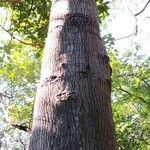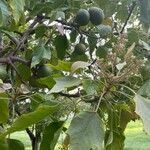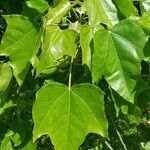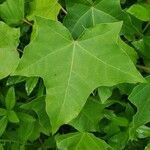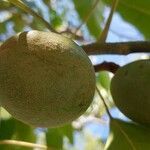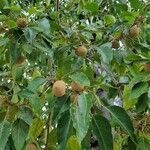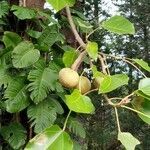A large tree up to 40 m tall and 1 m through at the base. The bark is rough. The leaves are large and can be round, triangular or have several lobes. The leaves have a pale colour. The leaves are alternate, silvery green and crowded near the tips. Young leaves are hairy and sometimes lobed. The leaves, leaf stalks and flowers are all covered with short soft hairs. There are 2 distinct brown glands where the leaf blade and stalk join. The flowers are small and white and in large groups on the ends of branches. Male and female flowers are separate but on the same tree. The female flowers are on the end surrounded by small male flowers. The fruit is a large (4 to 5 cm across) green 2 lobed berry with 1 or 2 large (2.5 cm across) seeds with a hard corrugated shell. They do not open naturally to release the seeds.
Large spreading tree to 30 m high. Indumentum silver. Leaf petioles 35–110 mm long; lamina entire or 3-or 5-lobed, ovate, ovate-lanceolate or ovate-trullate, 70–200 mm long, 40–130 mm wide, lower surface glabrous or with scattered silver stellate hairs when young. Flowers 5–8 mm long; petals oblanceolate to spathulate. Male flowers: pedicels 5.5–8 mm long; stamens 18–26; filaments 0.8–1.5 mm long, with sparse stellate hairs. Female flowers: pedicels 2–3.5 mm long; ovaries 1-or 2-locular; styles 0.5–2 mm long. Fruit ovoid-subglobose, 40–45 mm long, 40–60 mm diam., 1-or 2-seeded. Seeds broadly ovoid, 23–32 mm long, 20–32 mm diam.
Leaf blades 7–24 × 4–20 cm, ovate-lanceolate to elliptic-lanceolate or ovate-trullate, entire or up to 5-lobed, apex and lobes subacute to acutely acuminate, entire or shallowly repand-dentate on the margins, cuneate to truncate or shallowly cordate at the base, with 2 discoid, sessile, contiguous, shiny glands adaxially at the base, 3–5(7)-nerved from the base, densely cinereous-, fulvous-or ferrugineous-stellate-tomentose on both surfaces at first, later glabrescent.
Male flowers: pedicels 7–10 mm long, slender; buds 2 mm long, ovoid; calyx lobes 3–3.5 × 2–3 mm, ovate, acute, stellate-tomentose without, glabrous within; petals 6–8 × 2 mm, narrowly oblong-spathulate, obtuse, glabrous, yellowish-white; disk glands 0.5 × 0.5 mm, shallowly 3-lobed, flattened, whitish; staminal column 4 mm high, filaments c. 1 mm long, green, puberulous with simple hairs, anthers 0.5 mm long and wide, yellowish; receptacle puberulous.
Female flowers: pedicels 3–4.5 mm long, stout, dilated upwards; buds 4 mm long, conical; petals 1.5 mm wide, otherwise as in male flowers; disk c. 2 mm across, flattened; ovary c. 1.5 × 2 mm, subglobose, densely appressed-stellate-tomentose; styles c. 1 mm long, glabrous except at the base without.
Fruit 4 × 4–5.5 cm, ovoid-subglobose or transversely-ovoid, shallowly 2-lobed and with 4 low longitudinal ridges, evenly to sparingly appressed-or scurfily stellate-pubescent, green.
Young shoots, petioles and inflorescence axes densely scurfily fulvous to ferrugineous stellate-tomentose.
Seeds 2.5 × 2.75 × 2.25 cm, broadly ovoid, shallowly rugulose, brown mottled cream-coloured or whitish.
Inflorescences 10–16 × 10–14 cm, broadly conical, branching from the base; bracts 2–3 mm long.
A tree up to 10 m tall with a rounded crown.
Stipules minute, subulate.
Petioles 6–22 cm long.
Bark smooth, grey.
